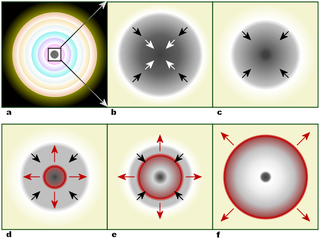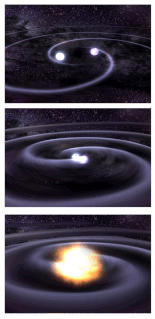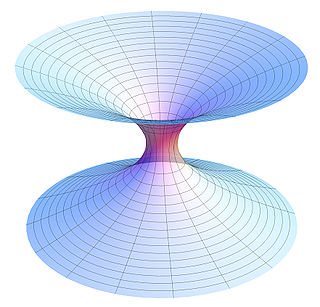
Physical cosmology is a branch of cosmology concerned with the study of cosmological models. A cosmological model, or simply cosmology, provides a description of the largest-scale structures and dynamics of the universe and allows study of fundamental questions about its origin, structure, evolution, and ultimate fate. Cosmology as a science originated with the Copernican principle, which implies that celestial bodies obey identical physical laws to those on Earth, and Newtonian mechanics, which first allowed those physical laws to be understood. Physical cosmology, as it is now understood, began with the development in 1915 of Albert Einstein's general theory of relativity, followed by major observational discoveries in the 1920s: first, Edwin Hubble discovered that the universe contains a huge number of external galaxies beyond the Milky Way; then, work by Vesto Slipher and others showed that the universe is expanding. These advances made it possible to speculate about the origin of the universe, and allowed the establishment of the Big Bang theory, by Georges Lemaître, as the leading cosmological model. A few researchers still advocate a handful of alternative cosmologies; however, most cosmologists agree that the Big Bang theory best explains the observations.

General relativity, also known as the general theory of relativity, is the geometric theory of gravitation published by Albert Einstein in 1915 and is the current description of gravitation in modern physics. General relativity generalizes special relativity and refines Newton's law of universal gravitation, providing a unified description of gravity as a geometric property of space and time or four-dimensional spacetime. In particular, the curvature of spacetime is directly related to the energy and momentum of whatever matter and radiation are present. The relation is specified by the Einstein field equations, a system of partial differential equations.

In physics, string theory is a theoretical framework in which the point-like particles of particle physics are replaced by one-dimensional objects called strings. String theory describes how these strings propagate through space and interact with each other. On distance scales larger than the string scale, a string looks just like an ordinary particle, with its mass, charge, and other properties determined by the vibrational state of the string. In string theory, one of the many vibrational states of the string corresponds to the graviton, a quantum mechanical particle that carries gravitational force. Thus string theory is a theory of quantum gravity.

A theory of everything, final theory, ultimate theory, or master theory is a hypothetical, singular, all-encompassing, coherent theoretical framework of physics that fully explains and links together all physical aspects of the universe. Finding a TOE is one of the major unsolved problems in physics. String theory and M-theory have been proposed as theories of everything. Over the past few centuries, two theoretical frameworks have been developed that, together, most closely resemble a TOE. These two theories upon which all modern physics rests are general relativity and quantum mechanics. General relativity is a theoretical framework that only focuses on gravity for understanding the universe in regions of both large scale and high mass: stars, galaxies, clusters of galaxies etc. On the other hand, quantum mechanics is a theoretical framework that only focuses on three non-gravitational forces for understanding the universe in regions of both small scale and low mass: sub-atomic particles, atoms, molecules, etc. Quantum mechanics successfully implemented the Standard Model that describes the three non-gravitational forces – strong nuclear, weak nuclear, and electromagnetic force – as well as all observed elementary particles.

The Alcubierre drive, Alcubierre warp drive, or Alcubierre metric is a speculative warp drive idea based on a solution of Einstein's field equations in general relativity as proposed by theoretical physicist Miguel Alcubierre during his PhD study at the University of Wales, Cardiff, by which a spacecraft could achieve apparent faster-than-light travel if a configurable energy-density field lower than that of the vacuum could be created.

A gravitational singularity, spacetime singularity or simply singularity is a location in spacetime where the density and gravitational field of a celestial body is predicted to become infinite by general relativity in a way that does not depend on the coordinate system. The quantities used to measure gravitational field strength are the scalar invariant curvatures of spacetime, which includes a measure of the density of matter. Since such quantities become infinite at the singularity point, the laws of normal spacetime break down.

Loop quantum gravity (LQG) is a theory of quantum gravity, which aims to merge quantum mechanics and general relativity, incorporating matter of the Standard Model into the framework established for the pure quantum gravity case. As a candidate for quantum gravity, LQG competes with string theory.
In black hole theory, the black hole membrane paradigm is a simplified model, useful for visualising and calculating the effects predicted by quantum mechanics for the exterior physics of black holes, without using quantum-mechanical principles or calculations. It models a black hole as a thin, classically radiating surface at or vanishingly close to the black hole's event horizon. This approach to the theory of black holes was created by Kip S. Thorne, R. H. Price and D. A. Macdonald.
In particle physics, the hypothetical dilaton particle is a particle of a scalar field that appears in theories with extra dimensions when the volume of the compactified dimensions varies. It appears as a radion in Kaluza–Klein theory's compactifications of extra dimensions. In Brans–Dicke theory of gravity, Newton's constant is not presumed to be constant but instead 1/G is replaced by a scalar field and the associated particle is the dilaton.

Gravitational collapse is the contraction of an astronomical object due to the influence of its own gravity, which tends to draw matter inward toward the centre of gravity. Gravitational collapse is a fundamental mechanism for structure formation in the universe. Over time an initial, relatively smooth distribution of matter will collapse to form pockets of higher density, typically creating a hierarchy of condensed structures such as clusters of galaxies, stellar groups, stars and planets.

The black hole information paradox is a puzzle resulting from the combination of quantum mechanics and general relativity. Calculations suggest that physical information could permanently disappear in a black hole, allowing many physical states to devolve into the same state. This is controversial because it violates a core precept of modern physics—that, in principle, the value of a wave function of a physical system at one point in time should determine its value at any other time. A fundamental postulate of the Copenhagen interpretation of quantum mechanics is that complete information about a system is encoded in its wave function up to when the wave function collapses. The evolution of the wave function is determined by a unitary operator, and unitarity implies that information is conserved in the quantum sense.

A physical paradox is an apparent contradiction in physical descriptions of the universe. While many physical paradoxes have accepted resolutions, others defy resolution and may indicate flaws in theory. In physics as in all of science, contradictions and paradoxes are generally assumed to be artifacts of error and incompleteness because reality is assumed to be completely consistent, although this is itself a philosophical assumption. When, as in fields such as quantum physics and relativity theory, existing assumptions about reality have been shown to break down, this has usually been dealt with by changing our understanding of reality to a new one which remains self-consistent in the presence of the new evidence.
In theoretical physics, a Schwarzschild kugelblitz is a concentration of heat, light or radiation so intense that its energy forms an event horizon and becomes self-trapped: according to general relativity and the equivalence of mass and energy, if enough radiation is aimed into a region, the concentration of energy can warp spacetime enough for the region to become a black hole, although this would be a black hole whose original mass–energy had been in the form of radiant energy rather than matter. In simpler terms, a kugelblitz is a black hole formed from radiation as opposed to matter. Such a black hole would nonetheless have properties identical to one of equivalent mass and angular momentum formed in a more conventional way, in accordance with the no-hair theorem.

Gravitational-wave astronomy is an emerging branch of observational astronomy which aims to use gravitational waves to collect observational data about objects such as neutron stars and black holes, events such as supernovae, and processes including those of the early universe shortly after the Big Bang.
The BTZ black hole, named after Máximo Bañados, Claudio Teitelboim, and Jorge Zanelli, is a black hole solution for (2+1)-dimensional topological gravity with a negative cosmological constant.

Jürgen Ehlers was a German physicist who contributed to the understanding of Albert Einstein's theory of general relativity. From graduate and postgraduate work in Pascual Jordan's relativity research group at Hamburg University, he held various posts as a lecturer and, later, as a professor before joining the Max Planck Institute for Astrophysics in Munich as a director. In 1995, he became the founding director of the newly created Max Planck Institute for Gravitational Physics in Potsdam, Germany.

The Ehlers–Geren–Sachs theorem, published in 1968 by Jürgen Ehlers, P. Geren and Rainer K. Sachs, shows that if, in a given universe, all freely falling observers measure the cosmic background radiation to have exactly the same properties in all directions, then that universe is an isotropic and homogeneous FLRW spacetime, if the one uses a kinetic picture and the collision term vanishes, i.e. in the so-called Vlasov case or if there is a so-called detailed balance. This result was later extended to the full Boltzmann case by R. Treciokas and G.F.R. Ellis.

Theoretical physics is a branch of physics that employs mathematical models and abstractions of physical objects and systems to rationalize, explain and predict natural phenomena. This is in contrast to experimental physics, which uses experimental tools to probe these phenomena.
In theoretical physics, back-reaction is often necessary to calculate the self-consistent behaviour of a particle or an object in an external field.

In astrophysics, an event horizon is a boundary beyond which events cannot affect an observer. The term was coined by Wolfgang Rindler.












